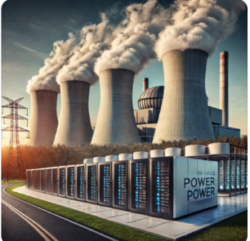The world’s energy appetite is skyrocketing—fueled by AI, data centers, and the relentless push for electrification. According to the U.S. Energy Information Administration, power consumption in the U.S. is projected to surge by as much as 20–30% over the next decade. That’s not an idle statistic; it’s a clarion call to prepare for a future where our grid is pushed to its limits.
Data centers, which now account for roughly 1% of global electricity consumption, are just one piece of the puzzle. As AI and cloud computing expand, that figure is only set to climb, further straining an already stressed power grid. And then there’s the rapid electrification of transportation, residential heating, and even industrial processes—a trend that the International Energy Agency warns will add hundreds of gigawatts of new demand by mid-century.
Let’s be frank: for all their green appeal, wind and solar aren’t the catch-all solution many would have you believe. The wind is capricious, the sun doesn’t always shine, and solar farms inadvertently elevate local temperatures. Recycling wind turbine blades is a challenge, backup batteries contribute to pollution during manufacturing, and even offshore wind farms have drawbacks linked to marine life concerns. Hydroelectric power, too, is limited by geography; there are only so many rivers to tap.
This isn’t just about inefficiency—it’s a slow-motion disaster. Our blind faith in intermittent renewables is steering us toward a grid collapse. When hospitals go dark, and data centers grind to a halt, it won’t be because we lack options; it’ll be because we chose to ignore the real solution.
Enter nuclear power. Traditional nuclear plants deliver reliable, around-the-clock baseload power, and innovative small modular reactors (SMRs) offer unprecedented flexibility and scalability. Running 24/7, free from carbon emissions, and immune to weather’s whims, nuclear energy is the safest, cleanest, and most efficient energy source.
Sure, Three Mile Island belongs to a bygone era—a chapter from half a century ago. We’ve since learned our lessons, designing reactors that steer clear of fault lines (no more Diablo Canyon déjà vu). And let’s not forget: nuclear technology already powers floating cities like aircraft carriers and submarines, proving its mettle in even the most challenging conditions.
The time to act is now. With breakthrough advancements in safer fuels and the nimble start-up times of SMRs, nuclear isn’t your grandfather’s clunky, hazardous power plant—it’s the linchpin of a modern, resilient energy infrastructure. We must build more nuclear plants, champion SMR development, and reallocate subsidies from faltering solar and wind projects.
As a bonus, we can coordinate all our energy resources to repurpose them according to needs. I am thinking of oil for transportation and gas/coal for areas without pollution problems and by-passing unstable fault areas like California. And, of course, energy conservation might help, too: data centers in colder climes, such as northern Canada and Alaska, have more efficient cabling and transmission lines.
In a world where the lights may soon go dark, it’s time to choose reality over ideology and truth over wishful dreams.
